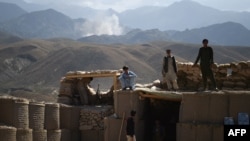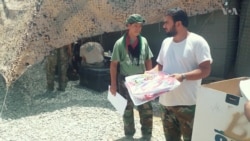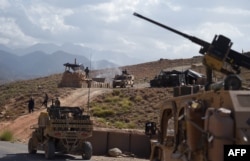U.S. and Afghan Special Forces on Sunday captured Islamic State's de facto caliphate capital in eastern Nangarhar province of Afghanistan.
Josh Thiel, a U.S. Special Forces battalion commander, told VOA that local nationals, who apparently were tired of IS atrocities, requested support to clear IS militants from Gur Guri and Papin villages.
"The operation started at the end of May. They [special forces] put direct fire on the ISIS capital caliphate and put it under siege for about four days. And it took the three commando companies five days to clear Papin and Gur Guri [of IS militants]," Theil added, using an acronym for Islamic State.
U.S. forces claim that more than 150 IS militants were killed during the past two months as they, with their Afghan partners, continue to crack down on IS militants in the area.
IS militants had a strong presence in Gur Guri and Papin, the largest villages in the Deh Bala district of eastern Nangarhar province, located along the border with Pakistan's Orokzai tribal area.
Foreign fighters
Locals in Deh Bala claim that most of the IS fighters are foreigners, including Pakistani nationals who easily cross into neighboring Afghanistan.
Mohammad Ghorzang, a local tribal elder, told VOA about 700 IS militants operate in eastern Nangarhar province.
"Russians, Chechens, Tajikistanis, Uzbekistanis, Arabs and mostly Pakistanis are among the IS militants fighting in eastern Nangarhar province," Ghorzang added.
On May 31, NATO's Resolute Support Mission in Afghanistan published a video of an unidentified Afghan local man who said, "This group calls themselves the Khorasan Kingdom. These are very undesirable people. They have brutalized and killed our women, our children and elders in Gur Guri village. They have expelled people from their homes, destroyed our mosques, and do not let us attend funerals."
U.S. Special Forces in Nangarhar said IS militants have been pushed back from their de facto caliphate in Nangarhar. However, local residents told VOA they fear IS militants have escaped to neighboring Kunar province, where they will intensify the violence.
Last week, Afghan officials in eastern Kunar province told VOA that Taliban and IS militants have been fighting fiercely in the province. Farid Dehqan, Kunar provincial police chief, told VOA that IS and Taliban militants had taken positions on high ground, targeting each other with small and heavy weaponry.
"Both sides have suffered casualties, but it is hard to say how many, due to a lack of communication services in the area," Dehqan said.
On July 3, the Afghan Ministry of Defense told VOA that Afghan forces targeted IS in eastern Kunar province and killed several fighters.
"We have conducted operations in eastern Kunar province targeting a group of IS militants and killed six of them. Our tactical operations are underway," General Mohammad Radmanesh, a spokesman for the Afghan Defense Ministry, told VOA.
IS's self-styled Khorasan province branch (IS-K) emerged in the mountainous areas of Afghanistan and Pakistan in 2015, and wreaked havoc in several Afghan provinces in north and eastern Afghanistan.







